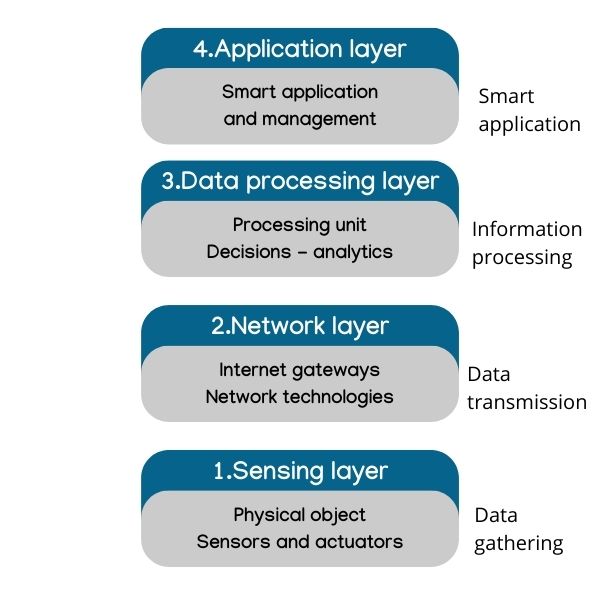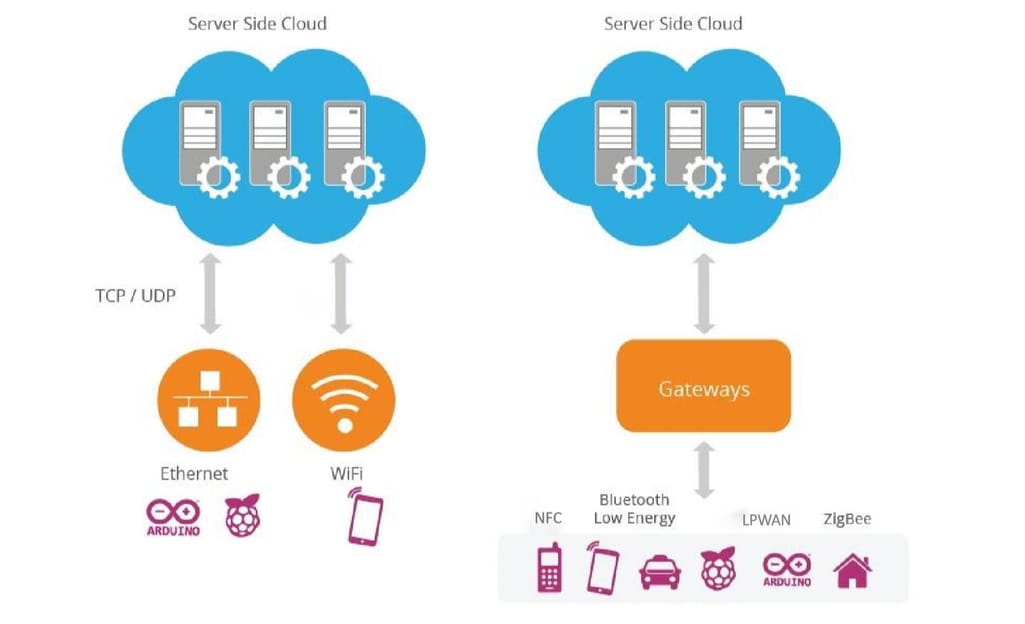HOME UNIT 1 UNIT 2 UNIT 3 UNIT 4 UNIT 5
Architecture of IOT
In simple terms, it is a process that consists of at least 4 stages or layers, which must work along to build the IoT architecture.
So, the architecture IoT requires connected hardware (that gathers data), a mean of communication to transmit the data to or from a cloud, a system that allows to process all data, and a data center (which can work in the cloud or in a local server) that will allow to store, handle, and analyze the information provided.
Types of layers of IoT architecture

The most common layers of Internet of Things architecture are 4, however, it doesn’t mean that every IoT device has the same amount, the minimum to guarantee a stable project is four layers, but depending on the complexity, an IoT product development company can decide to add more layers to the project.
1. Sensing layer:
This layer of IoT architecture contains all the different devices and sensors that are in charge of collecting data (from surroundings or specific tasks).
2.Network layer
This layer is responsible for the data transfer between the devices and the internet, this is made usually through a gateway that is in charge of adding additional processes.
In this layer, the most important part is protocol configuration, data encryption, malware protection, and authentication.
3.Data processing layer
This IoT architecture layer is in charge of managing all data analysis, but in a previous state of processing. This layer is very useful for IoT analytics. Another important aspect to consider, the data processing layer can be located in the gateway or in the cloud.
4.Application layer
This is where the data is processed and shown to the end-user. This IoT layer is usually located in the cloud. The application displays the data, and decisions can be made according to the information provided.
For instance, a person that is using a smart home system can see in his phone the temperature levels of the house thanks to the different temperature sensors installed in each IoT device. The user really doesn’t know which part of the system is performing a specific task of the IoT architecture, but all layers work together to deliver the data in such a way that it can be read and understood.
The skeleton of an IoT system.These elements make up the backbone of any IoT system upon which effective, multi-layered architecture can be developed. Most commonly, these layers are:
- the perception layer hosting smart things;
- the connectivity or transport layer transferring data from the physical layer to the cloud and vice versa via networks and gateways;
- the processing layer employing IoT platforms to accumulate and manage all data streams; and
- the application layer delivering solutions like analytics, reporting, and device control to end users.
Besides the most essential components, the article also describes three additional layers:
- the edge or fog computing layer performing data preprocessing close to the edge, where IoT things collect new information. Typically, edgy computing occurs on gateways;
- the business layer where businesses make decisions based on the data; and
- the security layer encompassing all other layers.
Often viewed as optional, these extra components none the less make an IoT project neatly fit modern business needs.
Perception layer: converting analog signals into digital data and vice versa
The initial stage of any IoT system embraces a wide range of “things” or endpoint devices that act as a bridge between the real and digital worlds. They vary in form and size, from tiny silicon chips to large vehicles. By their functions, IoT things can be divided into the following large groups.
Sensors such as probes, gauges, meters, and others. They collect physical parameters like temperature or humidity, turn them into electrical signals, and send them to the IoT system. IoT sensors are typically small and consume little power.
Actuators, translating electrical signals from the IoT system into physical actions. Actuators are used in motor controllers, lasers, robotic arms.
Machines and devices connected to sensors and actuators or having them as integral parts.
It’s important to note that the architecture puts no restriction on the scope of its components or their location. The edge-side layer can include just a few “things” physically placed in one room or myriads of sensors and devices distributed across the world.
Connectivity layer: enabling data transmission (IOT Enabling Technologies)
The second level is in charge of all communications across devices, networks, and cloud services that make up the IoT infrastructure. The connectivity between the physical layer and the cloud is achieved in two ways:
- directly, using TCP or UDP/IP stack;
- via gateways — hardware or software modules performing translation between different protocols as well as encryption and decryption of IoT data.

Two key models of connectivity between physical and cloud levels in IoT.
Source: WSO2
The communications between devices and cloud services or gateways involve different networking technologies.
Ethernet connects stationary or fixed IoT devices like security and video cameras, permanently installed industrial equipment, and gaming consoles.
WiFi, the most popular technology of wireless networking, is a great fit for data-intensive IoT solutions that are easy to recharge and operate within a small area. A good example of use is smart home devices connected to the electrical grid.
NFC (Near Field Communication) enables simple and safe data sharing between two devices over a distance of 4 inches (10 cm) or less.
Bluetooth is widely used by wearables for short-range communications. To meet the needs of low-power IoT devices, the Bluetooth Low-Energy (BLE) standard was designed. It transfers only small portions of data and doesn’t work for large files.
LPWAN (Low-power Wide-area Network) was created specifically for IoT devices. It provides long-range wireless connectivity on low power consumption with a battery life of 10+ years. Sending data periodically in small portions, the technology meets the requirements of smart cities, smart buildings, and smart agriculture (field monitoring).
ZigBee is a low-power wireless network for carrying small data packages over short distances. The outstanding thing about ZigBee is that it can handle up to 65,000 nodes. Created specifically for home automation, it also works for low-power devices in industrial, scientific, and medical sites.
Cellular networks offer reliable data transfer and nearly global coverage. There are two cellular standards developed specifically for IoT things. LTE-M (Long Term Evolution for Machines) enables devices to communicate directly with the cloud and exchange high volumes of data. NB-IoT or Narrowband IoT uses low-frequency channels to send small data packages.
Once parts of the IoT solution are networked, they still need messaging protocols to share data across devices and with the cloud. The most popular protocols used in the IoT ecosystems are:
- DDS (the Data Distribution Service) which directly connects IoT things to each other and to applications addressing the requirements of real-time systems;
- AMQP (the Advanced Message Queuing Protocol) aiming at peer-to-peer data exchange between servers;
- CoAP (the Constrained Application Protocol), a software protocol designed for constrained devices — end nodes limited in memory and power (for example, wireless sensors). It feels much like HTTP but uses fewer resources;
- MQTT (the Message Queue Telemetry Transport), a lightweight messaging protocol built on top of TCP/IP stack for centralized data collection from low-powered devices.
Edge or fog computing layer: reducing system latency
This level is essential for enabling IoT systems to meet the speed, security, and scale requirements of the 5th generation mobile network or 5G. The new wireless standard promises faster speeds, lower latency, and the ability to handle many more connected devices, than the current 4G standard.
The idea behind edge or fog computing is to process and store information as early and as close to its sources as possible. This approach allows for analyzing and transforming high volumes of real-time data locally, at the edge of the networks. Thus, you save the time and other resources that otherwise would be needed to send all data to cloud services. The result is reduced system latency that leads to real-time responses and enhanced performance.
The scheme of communications between IoT devices, edge nodes, and cloud data centers. Source: DesignNews
Edge computing occurs on gateways, local servers, or other edge nodes scattered across the network. At this level, data can be:
- evaluated to determine if it needs further processing at higher levels,
- formatted for further processing,
- decoded,
- filtered, and
- redirected to an additional destination
To sum up, the first three layers see data in motion, as it is constantly moving and altering. Only on hitting the next level, is data finally at rest and available for use by consumer applications.

Comments
Post a Comment